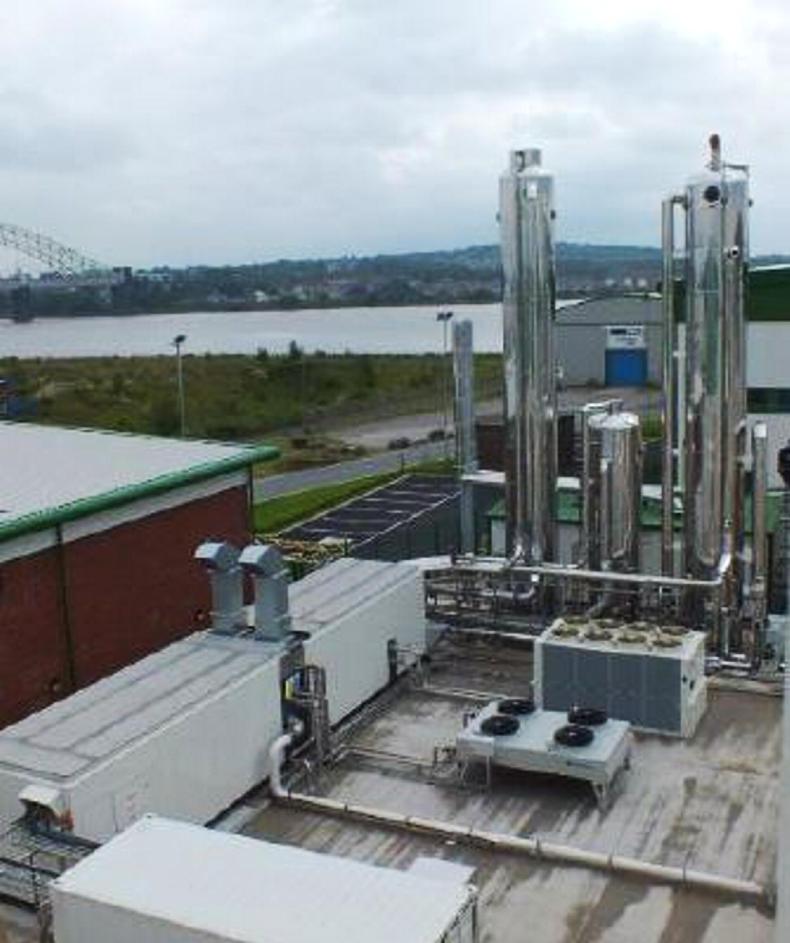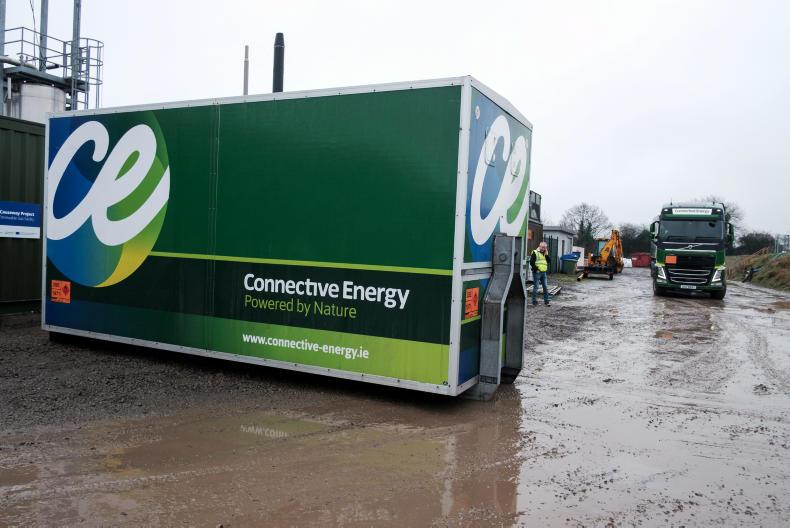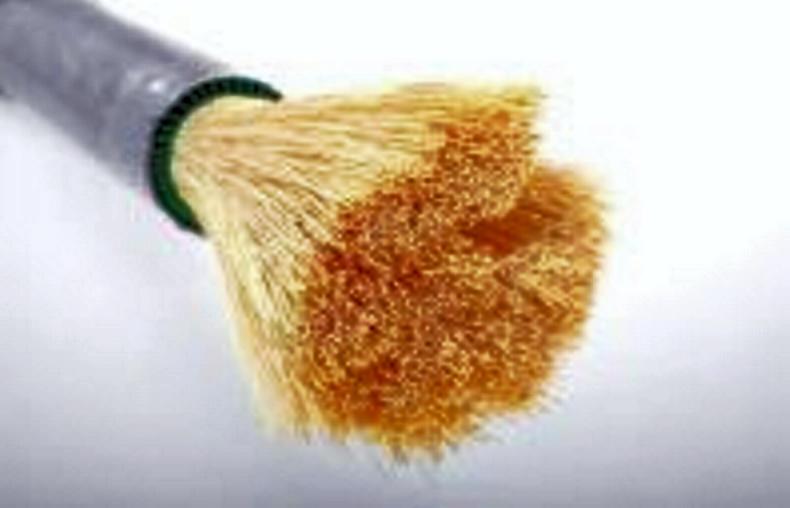Unlike many other European countries where biogas is combusted to make heat and electricity, Ireland’s biogas industry will centre on upgrading biogas to biomethane for injection into the national gas grid.
Biogas typically contains about 60% methane (CH4) and 40% carbon dioxide (CO2) but it also contains small amounts of water (H2O), oxygen (O2), hydrogen sulphide (H2S), ammonia (NH3) and other trace gases.
Before injection into the national gas grid, biogas needs to undergo further upgrading to remove the CO2 as well as any other trace gasses.
Depending on the gas upgrading technology, CO2 can also be recovered, liquefied and sold
This process creates biomethane, with a methane content of around 99%.
Biomethane closely resembles the properties of natural gas and can be injected directly into the national grid once quality standards are met.
Depending on the gas upgrading technology, CO2 can also be recovered, liquefied and sold.
There are a number of different biogas upgrading methods. Each has its own advantages and disadvantages but all of them require substantial investment.
Membrane separation
Membrane separation is the most widely used upgrading technique. This process sees biogas cooled, compressed and passed through thousands of ultra-thin porous membranes.
These membranes consist of long, thin fibres with a hollow core, typically 0.5mm to 1.0mm in diameter. The membrane surface has a higher selectivity for CO2 than methane.
Depending on the supplier, a separate scrubbing stage may be required to remove the H2S and other trace gasses
As the biogas passes through, smaller CO2 molecules permeate through the porous membrane, separating themselves from the methane molecules.
The process is typically repeated two to three times through other membranes until the desired methane purity is reached.
Depending on the supplier, a separate scrubbing stage may be required to remove the H2S and other trace gasses.
Membrane separation is compact, efficient and relatively simple. However, membranes are expensive to run and typically have a lifespan of five to 10 years.
Water washing
The second most common upgrading technique is water washing, which involves a two-stage process.
The first step takes place in a reactor tower, 12m to18m in height. Chilled water flows downwards in the tower while biogas flows upwards under high pressure.

An water wash biogas upgrading system.
Soluble gases like CO2 dissolve in the water, similar to the way in which CO2 stays dissolved in a carbonated soft drink container.
The gas extracted at the top of the tower is enriched in methane and saturated with water. To reduce the water vapour, this gas needs to be dried, which in turn creates biomethane.
The CO2 enriched water is brought to a second tower where the pressure is reduced, releasing most of the CO2, much like when pressure is released when opening a carbonated soft drink.
The result is CO2 gas. Any H2S in the biogas is generally absorbed in the process. Water used in this process is generally disposed of.
Pressure swing adsorption
Pressure swing adsorption (PSA) is a multi-stage upgrading system and is growing in popularity.
A typical PSA system is composed of four vessels that are each filled with an adsorbent media such as zeolites (crystalline polymers), carbon molecular sieves or activated carbon.
Each adsorbent media is capable of removing either water vapour, carbon dioxide, nitrogen or oxygen from biogas.
The system operates at lower pressures and therefore electricity demand is lower
As biogas enters each vessel, it is first compressed. The undesirable gasses are then removed as the biogas passes through the adsorbent media in each vessel.
After the four stages, the methane content of the remaining gas is around 99%.
The system operates at lower pressures and therefore electricity demand is lower.
However, as it is a multi-stage process, there is higher wear and tear on valves and seals.
Amine biogas scrubbing
With this method, CO2 contained in the raw biogas is almost completely removed by the use of a selective amine scrubbing solution.
The process takes place in two towers, similar to a water washing system.
The first step takes place in the reactor tower where an amine scrubbing solution flows downwards, while biogas flows upwards.

An amine biogas scrubbing system.
The amine solution absorbs CO2 but doesn’t react with the methane. As a result, the methane concentration in the biogas increases to around 99%.
In the second step, the scrubbing solution is heated to reverse the chemical reaction. The CO2 is discharged from the scrubbing solution for collection.
The amine scrubbing solution is then cooled and reused in the scrubbing tower in a closed loop system. This process may require additional scrubbing for other gasses.
Challenges
Anaerobic digestion of organic material can be divided into four different phases – hydrolysis, acidogenesis, acetogenesis and methanogenesis.
Each phase has its part to play in producing biogas and requires its own population of microorganisms.
If conditions such as feedstock nutrients, temperature, pH and digestion time are not correct at each phase, then the various populations of microorganisms will not thrive.
As a result, biogas yield will decrease. This will also affect biogas quality. The quality of raw biogas must be sufficiently high and consistent before it can be upgraded to biomethane.

Green Generation Ltd are successfully upgrading their biogas to biomethane.
This can be one of the key challenges of producing biogas for upgrading to biomethane, explains Michael McEniry of NRGE.
The Irish Farmers Journal recently spoke to Michael who explains that when first commissioning a plant, it will likely take several months, if not up to a year to fine tune digester operation to allow its microorganisms to produce biogas of sufficiently high quality for upgrading to biomethane.
This potential delay could impact gas sales and must be taken into consideration when planning a plant, he stressed.
Biogas contains around 60% methane and 40% carbon dioxide as well as other trace gasses.Biomethane is purified biogas with a methane concentration of around 99%. There are four main biogas upgrading methods.Biogas quality must be high and consistent before upgrading to biomethane. Read more
Listen: will the tillage industry miss out on Ireland’s biogas boom?
Biogas training course in Fermanagh
Unlike many other European countries where biogas is combusted to make heat and electricity, Ireland’s biogas industry will centre on upgrading biogas to biomethane for injection into the national gas grid.
Biogas typically contains about 60% methane (CH4) and 40% carbon dioxide (CO2) but it also contains small amounts of water (H2O), oxygen (O2), hydrogen sulphide (H2S), ammonia (NH3) and other trace gases.
Before injection into the national gas grid, biogas needs to undergo further upgrading to remove the CO2 as well as any other trace gasses.
Depending on the gas upgrading technology, CO2 can also be recovered, liquefied and sold
This process creates biomethane, with a methane content of around 99%.
Biomethane closely resembles the properties of natural gas and can be injected directly into the national grid once quality standards are met.
Depending on the gas upgrading technology, CO2 can also be recovered, liquefied and sold.
There are a number of different biogas upgrading methods. Each has its own advantages and disadvantages but all of them require substantial investment.
Membrane separation
Membrane separation is the most widely used upgrading technique. This process sees biogas cooled, compressed and passed through thousands of ultra-thin porous membranes.
These membranes consist of long, thin fibres with a hollow core, typically 0.5mm to 1.0mm in diameter. The membrane surface has a higher selectivity for CO2 than methane.
Depending on the supplier, a separate scrubbing stage may be required to remove the H2S and other trace gasses
As the biogas passes through, smaller CO2 molecules permeate through the porous membrane, separating themselves from the methane molecules.
The process is typically repeated two to three times through other membranes until the desired methane purity is reached.
Depending on the supplier, a separate scrubbing stage may be required to remove the H2S and other trace gasses.
Membrane separation is compact, efficient and relatively simple. However, membranes are expensive to run and typically have a lifespan of five to 10 years.
Water washing
The second most common upgrading technique is water washing, which involves a two-stage process.
The first step takes place in a reactor tower, 12m to18m in height. Chilled water flows downwards in the tower while biogas flows upwards under high pressure.

An water wash biogas upgrading system.
Soluble gases like CO2 dissolve in the water, similar to the way in which CO2 stays dissolved in a carbonated soft drink container.
The gas extracted at the top of the tower is enriched in methane and saturated with water. To reduce the water vapour, this gas needs to be dried, which in turn creates biomethane.
The CO2 enriched water is brought to a second tower where the pressure is reduced, releasing most of the CO2, much like when pressure is released when opening a carbonated soft drink.
The result is CO2 gas. Any H2S in the biogas is generally absorbed in the process. Water used in this process is generally disposed of.
Pressure swing adsorption
Pressure swing adsorption (PSA) is a multi-stage upgrading system and is growing in popularity.
A typical PSA system is composed of four vessels that are each filled with an adsorbent media such as zeolites (crystalline polymers), carbon molecular sieves or activated carbon.
Each adsorbent media is capable of removing either water vapour, carbon dioxide, nitrogen or oxygen from biogas.
The system operates at lower pressures and therefore electricity demand is lower
As biogas enters each vessel, it is first compressed. The undesirable gasses are then removed as the biogas passes through the adsorbent media in each vessel.
After the four stages, the methane content of the remaining gas is around 99%.
The system operates at lower pressures and therefore electricity demand is lower.
However, as it is a multi-stage process, there is higher wear and tear on valves and seals.
Amine biogas scrubbing
With this method, CO2 contained in the raw biogas is almost completely removed by the use of a selective amine scrubbing solution.
The process takes place in two towers, similar to a water washing system.
The first step takes place in the reactor tower where an amine scrubbing solution flows downwards, while biogas flows upwards.

An amine biogas scrubbing system.
The amine solution absorbs CO2 but doesn’t react with the methane. As a result, the methane concentration in the biogas increases to around 99%.
In the second step, the scrubbing solution is heated to reverse the chemical reaction. The CO2 is discharged from the scrubbing solution for collection.
The amine scrubbing solution is then cooled and reused in the scrubbing tower in a closed loop system. This process may require additional scrubbing for other gasses.
Challenges
Anaerobic digestion of organic material can be divided into four different phases – hydrolysis, acidogenesis, acetogenesis and methanogenesis.
Each phase has its part to play in producing biogas and requires its own population of microorganisms.
If conditions such as feedstock nutrients, temperature, pH and digestion time are not correct at each phase, then the various populations of microorganisms will not thrive.
As a result, biogas yield will decrease. This will also affect biogas quality. The quality of raw biogas must be sufficiently high and consistent before it can be upgraded to biomethane.

Green Generation Ltd are successfully upgrading their biogas to biomethane.
This can be one of the key challenges of producing biogas for upgrading to biomethane, explains Michael McEniry of NRGE.
The Irish Farmers Journal recently spoke to Michael who explains that when first commissioning a plant, it will likely take several months, if not up to a year to fine tune digester operation to allow its microorganisms to produce biogas of sufficiently high quality for upgrading to biomethane.
This potential delay could impact gas sales and must be taken into consideration when planning a plant, he stressed.
Biogas contains around 60% methane and 40% carbon dioxide as well as other trace gasses.Biomethane is purified biogas with a methane concentration of around 99%. There are four main biogas upgrading methods.Biogas quality must be high and consistent before upgrading to biomethane. Read more
Listen: will the tillage industry miss out on Ireland’s biogas boom?
Biogas training course in Fermanagh









 This is a subscriber-only article
This is a subscriber-only article










SHARING OPTIONS: